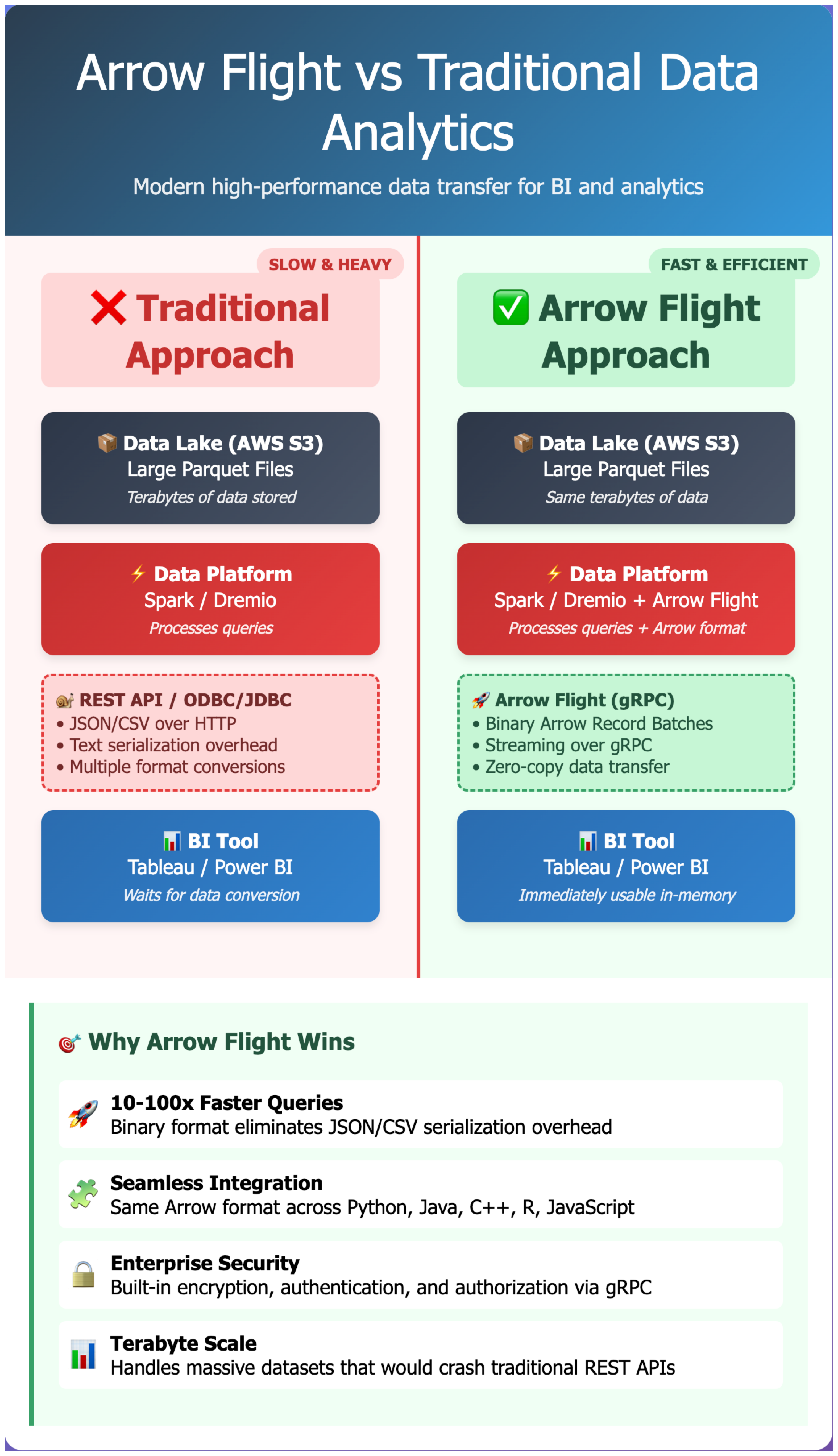[Avg. reading time: 18 minutes]
Apache Arrow
Apache Arrow is a universal columnar format and multi-language toolbox for fast data interchange and in-memory analytics. It contains a set of technologies that enable data systems to efficiently store, process, and move data.
It enables zero-copy reads, cross-language compatibility, and fast data interchange between tools (like Pandas, Spark, R, and more).
Why another format?
Traditional formats (like CSV, JSON, or even Parquet) are often optimized for storage rather than in-memory analytics.
Arrow focuses on:
- Speed: Using Vector Processing, the analytics tasks run up to 10x faster on modern CPUs with SIMD. (Single Instruction Multiple Data). One CPU instruction operated on multiple data elements at the same time.
Vector here means a sequence of data elements (like an array or a column). Vector processing is a computing technique where a single instruction operates on an Entire vector of data at once, rather than on one data point at a time.
Row-wise
Each element is processed one at a time.
data = [1, 2, 3, 4]
for i in range(len(data)):
data[i] = data[i] + 10
The CPU applies the addition across the entire vector at once.
Vectorized
data = [1, 2, 3, 4]
result = data + 10
-
Interoperability: Share data between Python, R, C++, Java, Rust, etc. without serialization overhead.
-
Efficiency: Supports nested structures and complex types.
Arrow supports Zero-Copy.
Analogy: English speaker - audience who speaks different languages.
Parquet -> Speaker notes stored in document and read by different people and translated at their own pace.
Arrow -> Speech is instantly shared across different people in their native language, without additional serialization and deserilization. Using Zero-Copy.
-
NumPy = Optimized compute (fast math, but Python-only).
-
Parquet = Optimized storage (compressed, universal, but needs deserialization on read).
-
Arrow = Optimized interchange (in-memory, zero-copy, instantly usable across languages).
Demonstration (With and Without Vectorization)
import time
import numpy as np
import pyarrow as pa
N = 10_000_000
data_list = list(range(N)) # Python list
data_array = np.arange(N) # NumPy array
arrow_arr = pa.array(data_list) # Arrow array
np_from_arrow = arrow_arr.to_numpy() # Convert Arrow buffer to NumPy
# ---- Traditional Python list loop ----
start = time.time()
result1 = [x + 1 for x in data_list]
print(f"List processing time: {time.time() - start:.4f} seconds")
# ---- NumPy vectorized ----
start = time.time()
result2 = data_array + 1
print(f"NumPy processing time: {time.time() - start:.4f} seconds")
# ---- Arrow + NumPy ----
start = time.time()
result3 = np_from_arrow + 1
print(f"Arrow + NumPy processing time: {time.time() - start:.4f} seconds")
Read Parquet > Arrow table > NumPy view > ML model > back to Arrow > save Parquet.
Use Cases
Data Science & Machine Learning
- Share data between Pandas, Spark, R, and ML libraries without copying or converting.
Streaming & Real-Time Analytics
- Ideal for passing large datasets through streaming frameworks with low latency.
Data Exchange
- Move data between different systems with a common representation (e.g. Pandas → Spark → R).
Big Data
- Integrates with Parquet, Avro, and other formats for ETL and analytics.
Parquet vs Arrow
| Feature | Apache Arrow | Apache Parquet |
|---|---|---|
| Purpose | In-memory processing & interchange | On-disk storage & compression |
| Storage | Data kept in RAM (zero-copy) | Data stored on disk (columnar files) |
| Compression | Typically uncompressed (can compress via IPC streams) | Built-in compression (Snappy, Gzip) |
| Usage | Analytics engines, data exchange | Data warehousing, analytics storage |
| Query | In-memory, real-time querying | Batch analytics, query engines |
Think of Arrow as the in-memory twin of Parquet: Arrow is perfect for fast, interactive analytics; Parquet is great for long-term, compressed storage.
Terms to Know
RPC (Remote Procedure Call)
A Remote Procedure Call (RPC) is a software communication protocol that one program uses to request a service from another program located on a different computer and network, without having to understand the network's details.
Specifically, RPC is used to call other processes on remote systems as if the process were a local system. A procedure call is also sometimes known as a function call or a subroutine call.
Ordering (RPC) food via food delivery app. You don't know who takes the request, who prepares it, how its prepared, who delivers it or what the traffic is. RPC abstracts away the network communication and details between systems.
Example: Discord. WhatsApp. You just use your phone, but behind the scenes it does lot of things.
DEMO
git clone https://github.com/gchandra10/python_rpc_demo.git
Arrow Flight
Apache Arrow Flight is a high-performance RPC (Remote Procedure Call) framework built on top of Apache Arrow.
It’s designed to efficiently transfer large Arrow datasets between systems over the network — avoiding slow serialization steps common in traditional APIs.
Uses gRPC under the hood for network communication.
Arrow vs Arrow Flight
| Feature | Apache Arrow | Arrow Flight |
|---|---|---|
| Purpose | In-memory, columnar format | Efficient transport of Arrow data |
| Storage | Data in-memory (RAM) | Data transfer between systems |
| Serialization | None (data is already Arrow) | Uses Arrow IPC but optimized via Flight |
| Communication | No network built-in | Uses gRPC for client-server data transfer |
| Performance | Fast in-memory reads | Fast networked transfer of Arrow data |

Arrow Flight SQL
- Adds SQL support on top of Arrow Flight.
- Submit SQL queries to a server and receive Arrow Flight responses.
- Easier for BI tools (e.g. Tableau, Power BI) connect to a Flight SQL server.
ADBC
ADBC stands for Arrow Database Connectivity. It’s a set of libraries and standards that define how to connect to databases using Apache Arrow data structures.
Think of it as a modern, Arrow-based alternative to ODBC/JDBC — but built for columnar analytics and big data workloads.